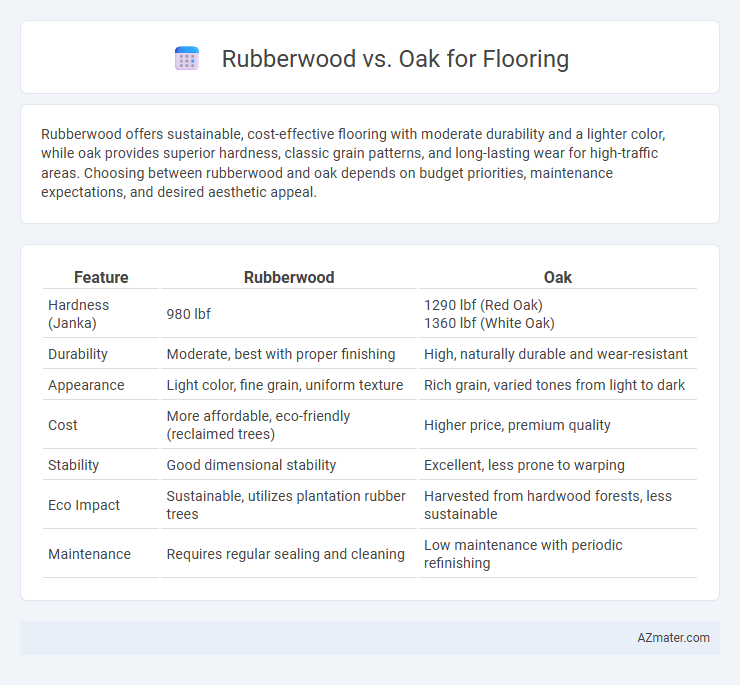Rubberwood offers sustainable, cost-effective flooring with moderate durability and a lighter color, while oak provides superior hardness, classic grain patterns, and long-lasting wear for high-traffic areas. Choosing between rubberwood and oak depends on budget priorities, maintenance expectations, and desired aesthetic appeal.
Table of Comparison
| Feature | Rubberwood | Oak |
|---|---|---|
| Hardness (Janka) | 980 lbf | 1290 lbf (Red Oak) 1360 lbf (White Oak) |
| Durability | Moderate, best with proper finishing | High, naturally durable and wear-resistant |
| Appearance | Light color, fine grain, uniform texture | Rich grain, varied tones from light to dark |
| Cost | More affordable, eco-friendly (reclaimed trees) | Higher price, premium quality |
| Stability | Good dimensional stability | Excellent, less prone to warping |
| Eco Impact | Sustainable, utilizes plantation rubber trees | Harvested from hardwood forests, less sustainable |
| Maintenance | Requires regular sealing and cleaning | Low maintenance with periodic refinishing |
Introduction to Rubberwood and Oak Flooring
Rubberwood flooring, derived from para rubber trees primarily grown in Southeast Asia, offers an eco-friendly and sustainable option due to its use of harvested latex trees after their latex production declines. Oak flooring, known for its durability and classic appearance, is made from hardwood species like Red Oak and White Oak, widely valued in North America and Europe for its strength and rich grain patterns. Both materials provide distinct benefits, with rubberwood being cost-effective and light-colored, while oak delivers long-term resilience and timeless aesthetic appeal.
Origin and Characteristics of Rubberwood
Rubberwood, also known as parawood, originates from the Para rubber tree primarily found in Southeast Asia, where it is harvested after the trees stop producing latex, making it an eco-friendly choice. This hardwood features a light color with a straight grain pattern, offering durability and resistance to wear, although it is softer than oak and may require protective finishes to enhance longevity. Its sustainable sourcing from plantation trees and fine grain texture make rubberwood a popular, cost-effective alternative to traditional hardwood flooring materials like oak.
Key Features of Oak Flooring
Oak flooring is prized for its exceptional durability and distinctive grain patterns, making it a popular choice in high-traffic areas. Its natural resistance to wear and ability to age gracefully allow for long-lasting performance and timeless appeal. Oak's versatility in staining and finishing options offers homeowners flexibility in achieving a wide range of interior design styles.
Durability Comparison: Rubberwood vs Oak
Rubberwood offers moderate durability with a Janka hardness rating around 960, making it suitable for low to medium traffic areas, whereas oak boasts a significantly higher hardness rating of 1290 to 1360, providing superior resistance to dents and scratches. Oak flooring exhibits greater longevity and resilience in high-traffic environments due to its dense grain structure, while rubberwood's softer composition may show wear more quickly under heavy use. Choosing oak ensures enhanced durability and maintenance ease for long-term flooring applications compared to rubberwood.
Aesthetic Differences Between Rubberwood and Oak
Rubberwood flooring features a light, uniform grain with subtle, creamy tones that brighten spaces and create a contemporary feel. Oak flooring offers a richer color palette, ranging from warm honey to deep reddish hues, with pronounced grain patterns adding rustic character and depth. The distinct aesthetic qualities of rubberwood provide a modern, clean look, while oak's varied textures enhance traditional and classic interior designs.
Environmental Impact and Sustainability
Rubberwood flooring is highly sustainable as it repurposes timber from rubber trees at the end of their latex-producing cycle, reducing waste and deforestation. Oak, while durable, is often harvested from slower-growing hardwood forests, resulting in higher environmental strain and longer regeneration periods. Choosing rubberwood supports eco-friendly flooring solutions by optimizing resource use and minimizing carbon footprint.
Cost and Affordability Insights
Rubberwood flooring offers a cost-effective alternative to oak, with prices typically 30-50% lower, making it ideal for budget-conscious projects. Oak flooring, known for its durability and premium aesthetic, carries a higher price point due to its hardwood quality and long lifespan. Choosing rubberwood helps reduce upfront expenses without compromising on the look of natural wood, while oak presents a valuable investment for long-term wear and resale value.
Installation and Maintenance Requirements
Rubberwood flooring offers easier installation due to its lighter weight and uniform density compared to oak, which is denser and may require professional tools and skills for precise fitting. Maintenance of rubberwood floors involves regular sweeping and occasional damp mopping, benefiting from a durable finish that resists moisture better than untreated oak, which demands more frequent sealing and careful humidity control to prevent warping. Both woods require refinishing over time, but rubberwood's dimensional stability typically reduces the frequency and complexity of upkeep compared to oak flooring.
Pros and Cons of Rubberwood Flooring
Rubberwood flooring offers eco-friendly benefits by utilizing plantation-grown trees harvested after latex production, making it a sustainable choice. It is relatively affordable, moderately hard with a Janka hardness rating around 980, and has good resistance to abrasion and dents, but is less durable than oak, which scores about 1,290 on the Janka scale. Rubberwood's susceptibility to moisture and mold requires proper sealing and humidity control, whereas its lighter color and uniform grain provide a warm, contemporary aesthetic compared to the varied texture of oak flooring.
Pros and Cons of Oak Flooring
Oak flooring offers exceptional durability and a classic aesthetic, making it a popular choice for high-traffic areas and traditional interior designs. Its natural grain patterns and rich tones provide warmth and elegance, but oak can be more expensive and prone to scratching compared to softer woods like rubberwood. Maintenance includes regular sealing to prevent moisture damage and occasional refinishing to restore its polished appearance, ensuring longevity.

Infographic: Rubberwood vs Oak for Flooring
 azmater.com
azmater.com